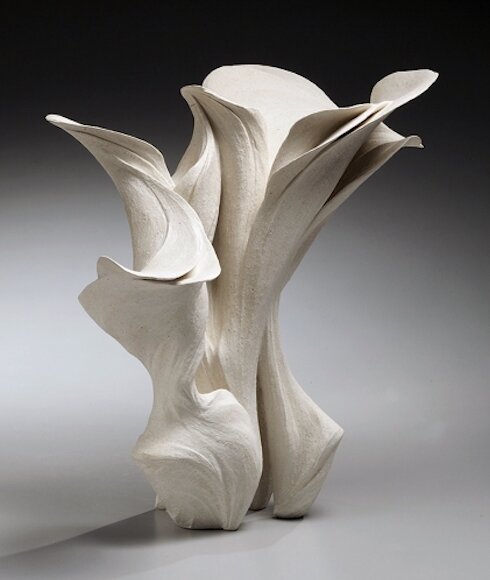Fujikasa Satoko (b.1980) is an exciting young artist who works primarily with clay of the Shigaraki region of Japan to create ethereal sculptures that seem to dance in the wind. The process is slow and meticulous, melding thin coils of clay together by hand. With delicate walls 2-3mm thick, the drying period often results in cracks, often demanding months to complete a single piece. In a press release by Joan B. Mirviss, her exclusive U.S. representation, Fujikasa explains,
“It is through my intimate dialogue with my medium that I am able to express nature’s fluid energy. Drawing from both the beauty and power of this world and the emotional response that they evoke, I hope to convey nature’s life force in the mind of the viewer.”
To date, Ms. Satoko has had two solo exhibitions in the U.S. The first, titled Form in Motion, was presented in 2015 and contained only 13 works due to the exceedingly delicate and time consuming process of creation. Although every piece was unlike anything I had ever seen, here are a few that especially caught my eye.
Blooming, 2012
Unglazed stoneware
14 1/2 x 14 1/2 x 8 1/2 in.
Flow, 2011
Slip-glazed stoneware
28 x 28 3/4 x 20 1/2 in.
Rotation, 2015
Slip-glazed stoneware
25 x 20 3/4 x 16 3/4 in.
Blossoming, 2014
Slip-glazed stoneware
27 x 22 x 20 in.
The second exhibition, titled Swirling Energy: The Sculptural Metaphors of Fujikasa Satoko, was presented in 2019 and contains 10 works.
Seraphim, 2016
Slip-glazed stoneware
26 3/8 x 25 1/8 x 17 3/4 in.
Rippling Waves, 2016
Slip-glazed stoneware
18 3/8 x 12 x 9 1/8 in.
Soaring Through the Heavens, 2018
Slip-glazed stoneware
26 x 33 x 16 in.
Effervescence, 2019
Slip-glazed stoneware
20 1/4 x 23 1/2 x 14 1/4 in.
Shigaraki Clay
Shigaraki is a small town in Kōka District, Shiga Prefecture, Japan. It is known for having one of Japan’s Six Ancient Kilns. Due to the rich mineral deposits in its soil and close vicinity to Nara and Kyoto, home of the first tea plantation in Japan in the year 816, Shigaraki naturally became a center for pottery. Stoneware from this region is known for the unique colors and finishes produced when fired in anagama wood-fire kilns.
-MM




